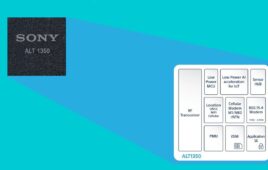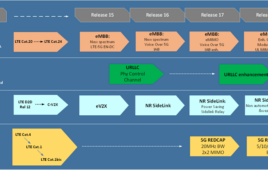smartphone user expectations for future broadband services.
Verizon Wireless’s Nov. 6 launch of the Motorola Droid smartphone may not have been accompanied by the breathless anticipation surrounding the 2007 introduction of the iPhone, but in many respects, its drama was higher. There is, after all, a lot riding on the Droid for a number of key players. And even though its operation is limited to 2G and 3G networks, there is also a good chance that the marketing of the Droid and its apps will have ramifications for the ultimate success of emerging 4G systems.
 Battered in recent years by declining market share and the general economic downturn, Motorola is hoping that the Droid, powered by Google’s Android operating system, will mark a turnaround in the fortunes of this once mighty brand. In a head-to-head competition with the iPhone, the Droid seems to have a lot going for it.
Battered in recent years by declining market share and the general economic downturn, Motorola is hoping that the Droid, powered by Google’s Android operating system, will mark a turnaround in the fortunes of this once mighty brand. In a head-to-head competition with the iPhone, the Droid seems to have a lot going for it.
First of all, operation on the Verizon network should provide greater availability of higher 3G bandwidths for data, and the generally superior quality of CDMA for voice. In functionality, the Droid has a more powerful processor and the convenience of a regular push-key user interface (including qwerty keyboard) in addition to an iPhone-style touch screen. But will Motorola be able to overcome the cache of the Apple brand? Evoking Star Wars imagery with the Droid name may prove to be a clever bit of marketing, but might it also lead some to dismiss it as a mere toy?
Google is perhaps the No. 1 name in the Internet “new economy” and has long sought ways to extend its reach into wireless, even to the point of contemplating building its own networks and/or handsets. It’s a pretty good bet that Google has made a wise choice in leaving the network and handset side to others and focusing instead on the user device operating system and applications. Besides Motorola, Google has licensed Android to most of the leading handset manufacturers, setting up a potential duopoly competition in mobile device platforms that parallels the one between Microsoft Windows and Apple in the computer world.
Speaking of Windows, if the Droid phone and the Android OS are highly successful, the biggest loser could be Microsoft, which also has longings for a major presence in wireless. If users take a liking to Android, in the Droid and other smartphones, that won’t leave much market space for Windows Mobile.
For Verizon, the stakes may not be quite as high as they are for Motorola, but there is still a lot riding on the Droid. While its balance sheet remains healthy and it continues to enjoy the lowest churn rate among national wireless operators, Verizon has lost quite a few customers to AT&T because of the iPhone. With the Droid, Verizon hopes to stop that trend and possibly even reverse it. I wouldn’t be a bit surprised to see a generous marketing initiative aimed at luring away iPhone users whose service agreements with AT&T are expiring.
 Of course, it’s not surprising that Droid’s success – or lack thereof – will have a big impact on the fortunes of Motorola, Google and Verizon. But how does its marketing by these companies weigh on the prospects for future 4G networks? By helping to establish smartphone user expectations for wireless broadband services.
Of course, it’s not surprising that Droid’s success – or lack thereof – will have a big impact on the fortunes of Motorola, Google and Verizon. But how does its marketing by these companies weigh on the prospects for future 4G networks? By helping to establish smartphone user expectations for wireless broadband services.
If one looks carefully at the introductory marketing hype being circulated for the Droid, mainly by Verizon, the resident capabilities of the device are emphasized. But what is hardly mentioned is the potential use of the 3G network for watching streaming video on that state-of-the-art, (relatively) large high-resolution screen. This is very telling because for a while the notion of streaming video has been a staple smartphone marketing ploy.
The problem is that any widespread demand for video and other bandwidth-hog applications will damage the economic viability of wireless data networks. These networks may offer impressive peak speeds (particularly as anticipated for 4G), but their channel throughput must be shared by all simultaneously served users. User satisfaction will therefore be greatest for applications that are enhanced by high peak data rates but which require only modest average throughputs.
Verizon and Google apparently understand this limitation on wireless data services because they seem to be promoting applications that fit the high peak speed/modest average throughput model. Google’s obvious forte is in searching and Web browsing support, and those apps, coupled with voice activation, are being highlighted in Verizon’s Droid marketing. Other 3G-friendly apps like e-mail services, map downloading and still photo sharing are also presented. By contrast, while the Droid has impressive capabilities for taking and recording video images, I couldn’t find any mention of using 3G networks to upload them.
Like the iPhone, the Droid will benefit from an almost limitless selection of third-party apps, some of which are bound to be real bandwidth hogs. Ultimate user satisfaction with the Droid, and with smartphones in general, will require that the use of such apps be constrained to limit their impact on network performance. Banning specific types of apps, like peer-to-peer file sharing and video downloads, is one, rather clumsy, way to do this. I hope that Verizon will come up with more elegant means of regulating Droid apps.
Time will tell, but I’m guessing that the Droid will be a big hit for Motorola, Verizon and Google. Expectations for success are not as clear in efforts to steer users toward apps that exploit the capabilities of 3G networks rather than fall prey to their limitations. The management of user preferences and expectations for smartphones on 3G networks could well be decisive in the future success of 4G.
Drucker is president of Drucker Associates. He may be contacted at edrucker@drucker-associates.com.




